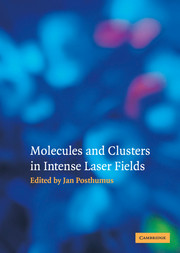Book contents
- Frontmatter
- Contents
- Preface
- 1 Ultra-high-intensity lasers based on Ti: sapphire
- 2 Diatomic molecules in intense laser fields
- 3 Small polyatomic molecules in intense laser fields
- 4 Coherent control in intense laser fields
- 5 Experimental studies of laser-heated rare-gas clusters
- 6 Single-cluster explosions and high-harmonic generation in clusters
- 7 Interactions of intense laser beams with extended cluster media
- Index
2 - Diatomic molecules in intense laser fields
Published online by Cambridge University Press: 29 March 2010
- Frontmatter
- Contents
- Preface
- 1 Ultra-high-intensity lasers based on Ti: sapphire
- 2 Diatomic molecules in intense laser fields
- 3 Small polyatomic molecules in intense laser fields
- 4 Coherent control in intense laser fields
- 5 Experimental studies of laser-heated rare-gas clusters
- 6 Single-cluster explosions and high-harmonic generation in clusters
- 7 Interactions of intense laser beams with extended cluster media
- Index
Summary
Introduction
When an intense laser pulse passes through a gas, the laser–matter interactions are highly non-linear and lead to extensive changes both in the nature of the transmitted light and the medium. Even if the excitation frequencies of the molecule are not in resonance with that of the light, the external electric field can exceed the internal binding forces and allow strong absorption of energy. Subsequently the energy is dissipated through explosive fragmentation of the molecule and by emission of high-frequency light. The physics of strongly correlated many-body quantum systems interacting with intense dynamic external fields is extremely complicated. The understanding of such processes in simple atoms is still in development, so it is fair to say that the mechanisms of multi-electron photodissociative ionisation of molecules are still far from being understood. Naturally the physical process of electron removal is very similar for both types of system. Indeed, the growth in interest in molecular dynamics in intense fields was originally fuelled by speculation on the character of multi-electron ejection from atoms. One of the topical issues of debate in molecular physics focuses on the sequence of the fragmentation; whether the electrons are liberated sequentially or simultaneously and how these processes depend on the nuclear motion. In light atoms the electron correlation in the outer shells is important irrespective of whether the electrons emerge sequentially, whereby the electrons are peeled off the atoms one by one, or escape in groups arising from a multiple collective excitation of the system.
- Type
- Chapter
- Information
- Molecules and Clusters in Intense Laser Fields , pp. 27 - 83Publisher: Cambridge University PressPrint publication year: 2001
- 5
- Cited by



